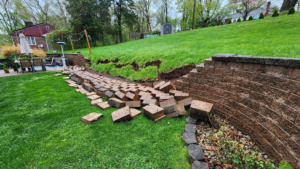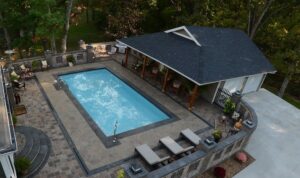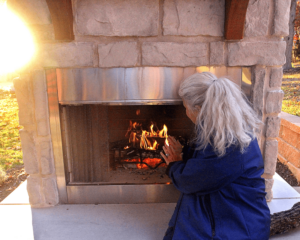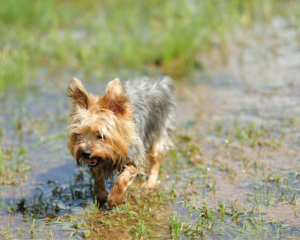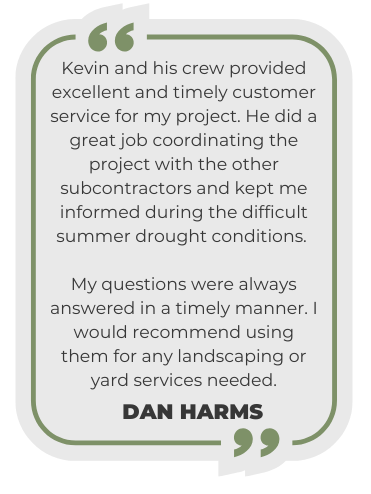Plant and Tree Care
Watering
This is probably the most important part of maintenance after your plants are installed. We have carefully planted your trees, shrubs, or flowers at the proper depth, location, and placement for optimal growth and aesthetics. The plants’ roots will take a few weeks to expand into the parent soil from the root ball. The following guidelines will help you and your plants for the next few months and beyond. They may be altered as needed based on natural rainfall, but only if that rain is substantial (substantial means rainfall is equal to or greater than 1”).
When to Water:
- Water new plants daily for the first 7-10 days.
- Water every other day for the next 10 days.
- Water as needed following the initial 17-20 days.
How to Water:
Hand watering is highly recommended at the base of the plant to cover the entire root zone. For trees or larger plants, we recommend using water drip bags. These bags hold 20 gallons of water and zip around the trunk to provide 6-8 hours of localized drip action. For smaller plants, use the following guidelines:
- Hold the water hose for approximately 60 seconds per plant at a normal flow rate.
- Keep water off the leaves of the plants, as it can lead to leaf scorch, fungus, etc.
- Excessive watering may lead to root rot.
- Test moisture with a finger 2-3” deep around the base of the plants.
- Allow soil to dry between waterings.
- Water frequently during drought, high temperatures, and windy periods.
Pruning
Pruning Trees
Evergreens: Prune back in winter, leaving a few inches of greenery on each branch to keep them looking healthy.
Ornamental Trees: Prune once in winter to create the desired shape and remove dead and diseased branches.
Shade Trees: Even shade trees need pruning as they grow. Remove diseased branches and some interior branches that will restrict airflow.
Pruning Shrubs
Prune shrubs once each winter by removing 1/3 to 1/2 of the plant. You’ll see better growth in the spring. The exception to this is plants that flower on old wood and Big Leaf Hydrangeas.
Pruning Flowers and Grasses
Remove spent flowers as they die throughout the season. In the winter, cut flowers down to 1-2″, with the exception of lavender (3-4″).
Cut ornamental grasses down to 6-8″ in the winter.
If you’d like us to take care of all the pruning and keep your landscape in great condition, have a look at our Landscape Preservation Plan.
Fertilizing
Just like our bodies, plants need supplemental nutrients. Below are some benefits of feeding plants:
- Promote vigorous growth.
- Help the plant survive or recover in times of stress.
- Promote stronger branches, flowers, and roots.
- Fight against insects and pathogens (fungus).
- Promote a healthy, full, and lustrous canopy.
It is recommended to fertilize ALL your plants at least twice a year, typically in spring and fall.
For newly planted trees and shrubs, we recommend a probiotic. This product will increase microbial action, allowing increased uptake of nutrients already in the soil. This will give the plant the best opportunity to establish itself without pushing growth too fast or burning. For established plants (older than one year), the probiotic should be applied twice a year; in fact, this treatment will reduce the amount of fertilizer needed in a given calendar year.
A lush green lawn is the best way to draw attention to your beautiful new landscape beds. We have a quality fertilization program that consists of granular applications, soil drenches, and probiotics when requested.
Tree Stakes
As needed, heavy-duty steel posts are used for newly installed trees/shrubs. Stakes are used for different reasons. One, to help anchor the plant and protect it against high winds and torrential rains. This prevents the plants from shifting or completely coming out of the ground. The stakes should remain for at least the first 12 months; this is the time when the plant has established its root system. Second, stakes will help keep the plants growing in an upright position and prevent leaning or a crooked growth habit. Maintaining a good structure for the plant will save time and money. A tree or shrub will self-correct if growing crooked but will leave a bend in the trunk, causing a weak point. Third, these stakes can provide a physical barrier at ground level to help stave off mower damage.
It is particularly important to completely remove the stakes, wires, and rubber pieces around 12 months after planting. This will help prevent the plant from growing around the wires and rubber pieces. Plus, the wires may inhibit the natural growth pattern of branches.
Fungicide/Insecticide
Almost every landscape plant used in southwest Missouri has the potential for damage from fungus, insects, or both at the same time. We live in a remarkably diverse area of the country known as the Transition Zone. This zone receives a wide array of extreme weather. We encounter extremely high temperatures, deep freeze temperatures, humidity, drought, etc. Because of these conditions, fungus and insects thrive. To combat these pests, we use fungicides and insecticides as needed.
Fungicides are best used as a preventative but will work as a knock-down upon contact. If you notice spots, bleaching, curling, or wilting symptoms, it may be fungus. Many times, these signs will appear quickly, even overnight, and should be dealt with as soon as possible. If not treated in a timely fashion, a plant (whether a tree, shrub, or flower) can quickly decline and may not recover.
Insects are a common problem as well. Most insects you can visibly see, either the insect itself, cocoons, bags, nests, or droppings. Others you may only see because of the damage they leave, such as chewed leaves, curling, leaf drop, or a struggling plant in general.
Grass Seeding & Sod Care
Lawn Seeding Aftercare
Seeding is the least expensive and most common process in creating a lawn. Just like with sod, seeding requires quality watering. To establish the grass quickly and efficiently, follow these steps:
Watering Seed
- Keep the area damp 3” down for the first month
- Water slowly with a fine spray to avoid erosion (fan/oscillating sprinkler works best)
- Watering in the morning is best, avoid late afternoon or evening to help prevent fungus
- Mow new grass to a height of 2”-2.5” to promote growth and thickening (allow the grassy area to dry enough to allow for a mower; if it is too muddy the mower will damage the ground/grass)
- Gradually raise mower height each time to achieve a final cutting height of 3-4”
- Continue long intermittent waterings weekly, achieving a total of 1 inch per week for optimal results
Fertilizing Seed
At the time that the seed is worked into the soil, a starter fertilizer is applied. This will provide vital nutrients for the seedlings as they take root, promoting quicker growth and a strong root system. Just like sod, it is highly recommended to utilize a fertilizer program to yield the best results for a strong and healthy lawn. A fertilizer application should be applied about 3 weeks after the initial installation.
Weeds & Seeding
Due to the seeding process, weeds (possibly quite a few) will emerge. This is because weed seed that already existed either in the soil or on the surface has now received the elements to germinate: water, light, and soil contact. This is a normal event and is expected. Broadleaf weeds can be sprayed after 3 mowings. Annual grassy weeds will die back in the colder months leading into winter. Preemergent/fertilizer applications the following spring will prevent annual grassy weeds from returning.
Other Notes About Seeding
Did you know it takes 6 months for grass to fully mature? In fact, a single seedling spike will grow to the size of your fist. This is the reason that seeding ideally takes place (primarily) in the fall. It allows the grass to germinate and begin establishing during cooler temperatures before going into the stressful summer months.
Sometimes seeding must take place at different times of the year due to restrictive circumstances. In these cases, the guidelines for care are the same but may need to be altered a bit and the results may take longer. The focus for seeding is good watering practices. If temperatures are cool, then it will take longer for germination and development.
Sod Aftercare
Watering Sod
This is the most important step for care after installation.
- First 2 weeks: Water entire area twice daily for 20-30 minutes
- Third week: Water once daily for 20-30 minutes
- Fourth week: Wean watering frequency back to 2-3 times per week
- Mow the sod after the second week on a tall setting (4”). Do not mow if muddy, allow the sod to dry enough to run mower over the grass. Water lawn after mowing
- Stay off the grass for at least 2 weeks to allow the roots to anchor
Fertilizing Sod
Fertilizing sod is important after it has been established. Depending on what time of year the sod was installed, fertilizing should follow 2-3 months later. The time of year will dictate which fertilizer is used.
Weeds & Sod
Sod itself will not come with weed seed since it’s well cared for at the sod farm, but sod is usually laid over bare soil or a mix of bare soil and existing grass. Weed seeds that were pre-existing on the parent soil may still germinate and push through the sod. Broadleaf weeds can be sprayed accordingly once there has been at least 2-3 mowings. Some grassy weeds (i.e., crabgrass/foxtail) will die back in the cold weather starting in fall. They can reseed themselves but can be prevented with a preemergent/fertilizer treatment the following spring. Other grassy weeds (perennial in nature such as Johnson grass, Bermuda grass, nimblewill, etc.) will have to be sprayed with a post-emergent herbicide rated specifically for grassy weeds, or hand pulled.
Preventing Fungus in Grass
While most soil fungi are beneficial, heavy rains or watering can cause an influx of harmful lawn fungus, which is the main cause of discoloration. If you notice any fungus, this article has many ideas for treatment and prevention.
Hardscape Care
Now that your hardscape elements are in place, please allow at least 24 hours for any glue, mortar, or polymeric sand to cure before use. Hardscape features are fairly maintenance free, but may require a little work from time to time. Keep your patio, fireplace, firepit, retaining wall, or kitchen clean with a good sweep followed by a gentle rinse. Never use a pressure washer to clean your hardscape features, the pressure will damage or remove grout or polymeric sand in the joints.
Maintenance
The sand used for your project will likely stand the test of time well. That said, it is possible that the area could benefit from a fresh layer in 10 years or so. To do this, remove the top 1/2″ (roughly) of sand either mechanically using an old screwdriver or with the use of a pressure washer. The pressure washer method is less laborious, but can be quite messy and it is easy to take a lot of material out. After allowing the area to dry completely, add new sand and carefully sweep into the joints. Once you have the exact look you want, spray the area with a gentle shower, being careful not to disturb the sand placement. Allow the sand to cure for 24 hours, and you have a brand new (looking) patio! Grout or mortar may also need a touch up in several years. This can be achieved from a tuck pointing job on the grout and does not require removing all of the existing mortar.
Preservation Plan
We highly recommend a yearly landscape/lawn preservation plan to protect your investment. Landscape plants will greatly benefit from pruning to promote good health, aesthetics, and proper growth.
You can learn more about the Landscape Preservation Plan here.
Lawns need supplemental nutrients to continue good health/growth. We offer fertilizing, plant probiotics, disease/insect/pest control, and mulching.
Please feel free to reach out to us for any questions concerning your property. We will be happy to provide you the information needed to tackle the project yourself, or we can give you a quote on preserving your investment and your outdoor environment. Thank you again!



